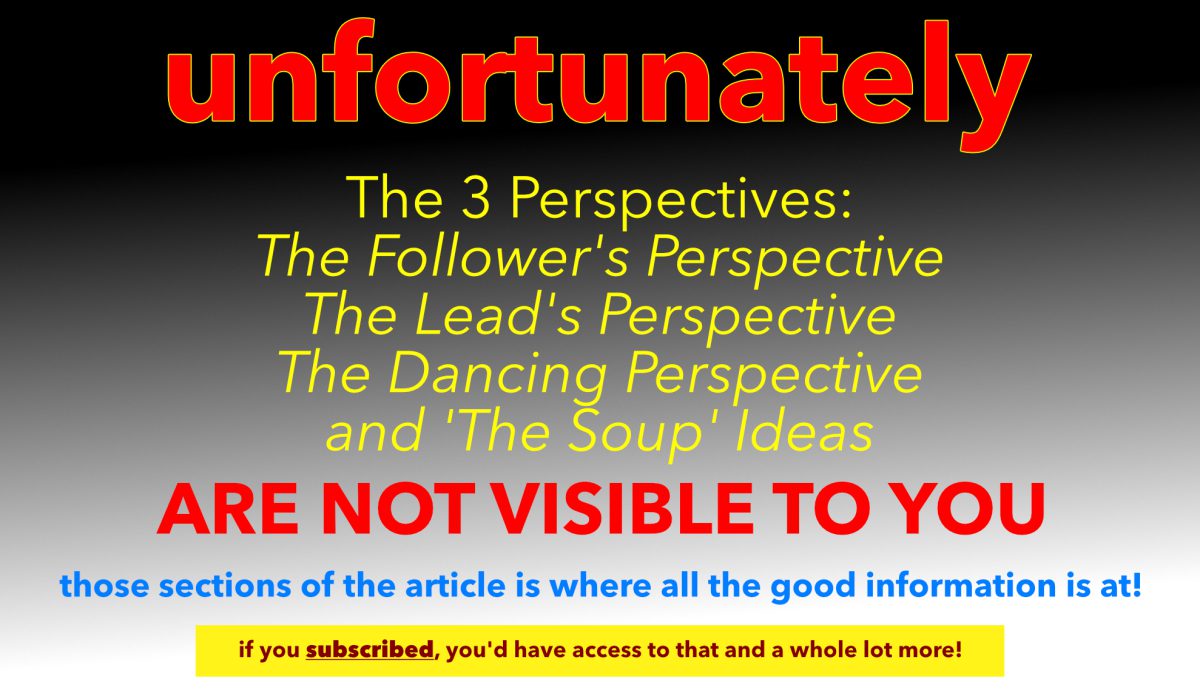There are Eight Turns in Argentine Tango that Tango Topics has identified as Commonly used or Social Turns. There are a few others that are outside of the common eight but for the most part, accept for now that there are eight.
Just in case you were curious, the Eight Common Turns are, in order of precedence and commonality: 1.) The Follower’s Molinete/Lead’s Giro. 2.) Milonguero Turn. 3.) Rock Step. 4.) Ocho Cortado. 5.) Calesitas. 6.) Media Luna Turns. 7.) Colgada Turns. 8.) Anti-Molinete.
Today’s Tango Topic deals with one of those common eight turns. This particular turn is an unusual one even though it’s part of the eight. It’s unusual because it’s a variation of a class of turns called “Colgada Turns”, and furthermore it’s also not used all that much, and for good reason. Why ? Because it’s a difficult turn to pull off at first. This one is not for the faint of heart, but once you master it, your coolness factor goes right through the roof. Not to mention you will have also mastered one of Tango’s more difficult aspects that hasn’t been around all that long in the dance: Off-Axis Movements. Tango has traditionally been a couple in Close Embrace type of dance that almost never opens once the Embrace begins. Nor does that Embrace change other than to get closer and closer and closer, and more refined. This type of turn, while done in Close Embrace, creates a version of Close Embrace that from the outside looking in, doesn’t look all that different, but from the inside (the couple’s perspective) feels very different. Today we’re going to explore both sides of the embrace, for both roles, so without further yapping, Tango Topics presents: The Single Axis Turn!
What Is A Single Axis Turn ? It is tango specific language to describe a type of rotation that occurs between Lead and Follow where the word ‘axis’ refers to not the Follower’s Longitudinal Axis (which is the typical axial line that is referenced with the use of the word ‘axis’) nor is it the Lead’s, but rather a shared Longitudinal Axis between the couple. Truth be told, that axial line is always present. It’s generally the point of contact between the couple. However that longitudinal axis almost never gets used in Social Tango. Almost never. Except, and there is always an exception to these things, when the couple or partnership engages in what’s called ‘Apilado‘ (please follow the link for more information if you need a clear definition of this word). When Apilado is engaged, then the couple is dancing, depending on how it’s done, in either a supported way (shared) or unsupported way (forced). In the latter case, the Follower is being forced to fall on top of the Lead or to place all of their weight on the Lead. While there are times when that is desirable, in the case of the Single Axis Turn, that’s not desirable.
Another way of looking at the Single Axis Turn is by understanding that this is a Colgada variation. However, unlike most Colgadas though which tend to be executed in Open Embrace, this variation on a theme is done primarily in Close Embrace! So while it can be done in Open Embrace, and doing so will generate more of a ‘whoosh’ factor (see below) than you would normally like to have in a Single Axis Turn, this is generally a Close Embrace movement that is small, social and fits within the line and lane of dance that you’re in. At no point in time, should a Single Axis Turn exit that line or lane of dance at all. The Single Axis Turn is Floorcraft safe, when done properly.
Another piece of Tango vocabulary that uses very similar methodology and uses the same principle of ‘Apilado’ is the Argentine Volcada. It is also a shared axis movement. The Single Axis Turn is exactly the same in that respect. However, where as in the case of the Volcada, where the couple goes towards each other thereby creating more dependence on each other, in this case, in the case of the Single Axis Turn they go away from each other!
Put simply the Single Axis Turn is a rotation around a shared longitudinal axial line where the couple seemingly in close or open embrace, rotates around this axial line, thereby creating a ‘turn’.
The Free Tip. Just as in the case of the Volcada, where there is a natural ‘kickstand’ for all Volcadas, a safety mechanism that the Follower can invoke, if they’re not supported in the initiation phase of the Volcada…the same thing is true here. That same safety mechanism exists in the Single Axis Turn in exactly the same way in EVERY. SINGLE. ONE.

About The Video. This video is 13m:49s in length in 9 sections. Both lead and follower technique are combined and integrated into the video.
Introduction – 00:00:34
Forward Steps – 00:03:09
Follower Technique for Forward Steps – 00:01:26
Further Rotation – 00:00:32
Close Embrace Side Steps – 00:01:47
Follower Technique for Side Steps – 00:00:53
Multiple Single Axis Turns – 00:01:47
The ‘Whoooosh’ Factor – 00:00:42
The Hurrican Turn/End – 00:02:09

